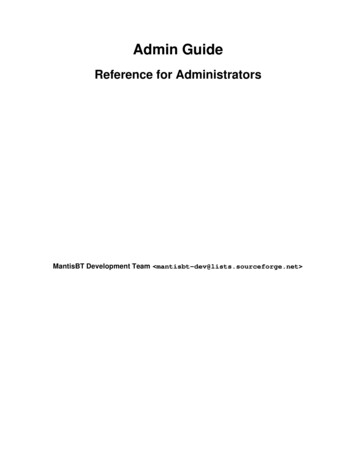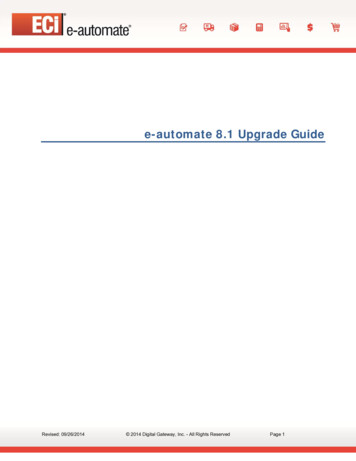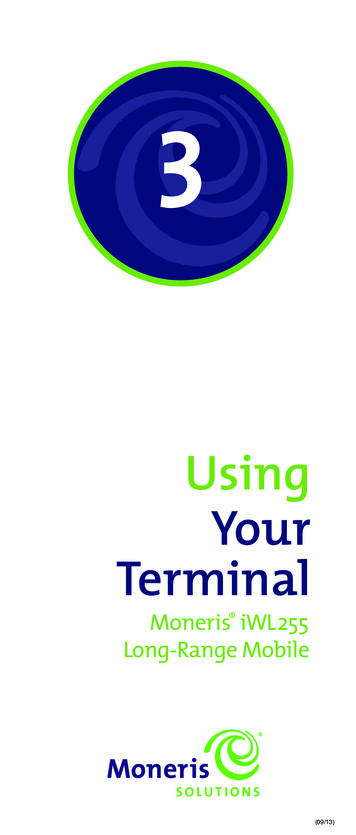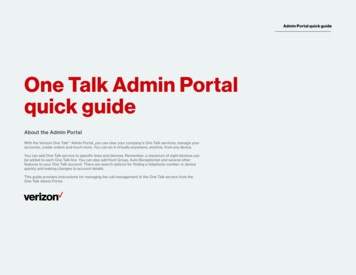
Transcription
Admin GuideReference for AdministratorsMantisBT Development Team mantisbt-dev@lists.sourceforge.net
Admin Guide: Reference for Administratorsby MantisBT Development TeamAbstractThis book is targeted at MantisBT administrators, and documents the installation, upgrade, configuration,customization and administration tasks required to operate the software.Copyright 2016 MantisBT team. This material may only be distributed subject to the terms and conditions set forth in the GNU FreeDocumentation License (GFDL), V1.2 or later (the latest version is presently available at http://www.gnu.org/licenses/fdl.txt).
Table of Contents1. About MantisBT . 1What is MantisBT? . 1Who should read this manual? . 1License . 1How to get it? . 1About the Name . 1History . 2Support . 2MantisBT News . 3Versioning . 32. Installation . 4Overview . 4System Requirements . 4Server Hardware Requirements . 4Server Software Requirements . 4Client Requirements . 7Pre-installation / upgrade tasks . 7New Installation . 8Upgrading . 8Configure your installation . 10Post-installation and upgrade tasks . 11Post-installation tasks . 11Post-upgrade tasks . 11Backups . 12MySQL Backups . 12Uninstall . 133. User Management . 14Creating User Accounts . 14Enabling/Disabling User Accounts . 14Deleting User Accounts . 15User Signup . 15Forgot Password and Reset Password . 15Impersonating a user . 16Changing Password . 16Pruning User Accounts . 16Authorization and Access Levels . 16Auto Creation of Accounts on Login . 17User Preferences . 17User Profiles . 184. Issue Lifecycle and Workflow . 19Issue Creation . 19Issue Statuses . 19Workflow . 20Workflow Transitions . 20Workflow Thresholds . 215. Configuration . 23Introduction . 23Database . 23Base Database settings . 23Database table naming settings . 24Path . 25iii
Admin GuideWebserver .Configuration Settings .Security and Cryptography .Signup and Lost Password .Email .DKIM signature .S/MIME signature .Version .Language .Display .Time .Date .Time Zone .News .Default Preferences .Summary .Bugnote .File Upload .HTML .Authentication .Global authentication parameters .LDAP authentication method parameters .Status Settings .Filters .Misc .Cookies .Speed Optimisation .Reminders .Bug History .Sponsorship .Custom Fields .My View Settings .Relationship Graphs .Wiki Integration .Sub-Projects .Field Visibility .System Logging and Debugging .Time Tracking .API .Disabling the webservice API .Anti-Spam Configuration .Due Date .User Management .View Page Settings .Issues visibility .Public/Private view status .Limited view configuration ."Limit reporters" configuration (deprecated) .6. Page descriptions .Login page .Main page .View Issues page .Issue View page .Issue Change Status page 96969697070
Admin GuideIssue Edit page . 71My Account Page . 71Preferences . 71Profiles . 71Manage Columns . 71API Tokens . 71System Management Pages . 72Users . 72Manage Projects Page . 72Manage Custom Fields . 72Global Profiles . 73Configuration . 73Monitor Issue . 76Reopen Issue . 76Delete Issue . 76Close Issue . 77Assign to Me . 77Resolve Issue . 77News Syndication . 777. Customizing MantisBT . 78Strings / Translations . 78Custom Fields . 78Overview . 78Custom Field Definition . 79Adding/Editing Custom Fields . 81Linking/Unlinking/Ordering Existing Custom Fields in Projects . 81Localizing Custom Field Names . 81Dynamic default values . 82Dynamic values for Enumeration Custom Fields . 82Enumerations . 84Email Notifications . 86Customizing Status Values . 87Custom Functions . 89Default Custom Functions . 89Example Custom Function Override . 908. Authentication . 92Standard Authentication . 92LDAP and Microsoft Active Directory . 92Basic Authentication . 92HTTP Authentication . 93Deprecated authentication methods . 939. Troubleshooting . 94Application Errors . 94Error 2800 - Invalid form security token . 9410. Project Management . 96Change Log . 96Roadmap . 98Time Tracking . 100Graphs . 100Summary Page . 10011. Contributing to MantisBT . 102Talent and Time . 102Recommend MantisBT to Others . 102Blog about MantisBT . 102v
Admin GuideIntegrate with MantisBT . 102A. Revision History . 103vi
List of Tables6.1. Issues . 75vii
Chapter 1. About MantisBTWhat is MantisBT?MantisBT is a web based bug tracking system that was first made available to the public in November2000. Over time it has matured and gained a lot of popularity, and now it has become one of the mostpopular open source bug/issue tracking systems. MantisBT is developed in PHP, with support to multipledatabase backends including MySQL, MS SQL and PostgreSQL.MantisBT, as a PHP script, can run on any operating system that is supported by PHP and has supportfor one of the DBMSes that are supported. MantisBT is known to run fine on Windows, Linux, macOSand a variety of Unix operating systems.Who should read this manual?This manual is targeted for the person responsible for evaluating, installing and maintaining MantisBT ina company. Typically we refer to this person as the MantisBT administrator.LicenseMantisBT is released under the terms of GNU General Public License (GPL) [https://www.gnu.org/copyleft/gpl.html]. MantisBT is free to use and modify. It is free to redistribute as long as you abide bythe distribution terms of the GPL [https://www.gnu.org/copyleft/gpl.html].How to get it?MantisBT is available in several Linux distributions including: Debian, Ubuntu, Fedora, Gentoo,Frugalware and others. Hence, if you are running Linux, start by checking if your distribution has a packagefor MantisBT. If not, or if the package is not up-to-date with the latest MantisBT version, then you maywant to download it directly from here [https://mantisbt.org/download.php].For Windows, macOS and other operating systems, use the link provided above to download MantisBT.The download is compressed in tar.gz or zip format. Both formats can be unpacked using tools like 7-Zip[https://www.7-zip.org/] (in case of Windows).Note that at any point in time there are typically two "latest" MantisBT releases that are available fordownload. The latest production release (stable), and the latest development release which can be an alphaor a release candidate. It is not recommended to use development releases in production specially if it isstill in the alpha stage unless the administrator is familiar with PHP and is able to troubleshoot and fixany issues that may arise.About the NameWhen initially seeking to name this project Ken ran into a problem every programmer encounters. What isa good name? It has to be descriptive, unique, and not too verbose. Additionally having multiple meaningswould be a nice touch. Quickly ruled out were php*Something* names which, incidentally, althoughpopular, do not seem to be condoned by the PHP Group developers. Drawing inspiration from OpenSource projects like Apache, Mozilla, Gnome, and so forth resulted in two eventual choices: Dragonflyand Mantis. Dragonfly was already the name of a webmail package. So the name became Mantis.1
About MantisBTPraying Mantis are insects that feed primarily on other insects and bugs. They are extremely desirable inagriculture as they devour insects that feed on crops. They are also extremely elegant looking creatures.So, we have a name that is fairly distinctive and descriptive in multiple ways. The BT suffix stands for"Bug Tracker" and distinguishes this project from general usage of the word Mantis. However, over timethe project was typically referred to as Mantis.HistoryKenzaburo Ito and a friend originally created a bug tracker as an internal tool for their pet project. A searchfor good, free packages came up with nothing suitable so they wrote their own. After a rewrite and cleanupit was made available to the public via the GNU General Public License (GPL). The GPL was chosenpartly because of his belief that development tools should be cheap or free. In 2002, Ken was joined byJeroen Latour, Victor Boctor and Julian Fitzell to be the administrators and the core development team ofMantisBT. This marks a new era in MantisBT lifetime where it is now a team project.SupportThere are plenty of resources to help answer support queries. Following are the main ones: Forums [https://mantisbt.org/forums/] - The forums are one of the most popular destinations for gettingMantisBT support. Start off by searching the forums for your questions, if not found, then go aheadand submit a question. Mailing lists [http://www.mantisbt.org/mailinglists.php] - Several lists are available, each of them withits own, specific purpose. Note that posting messages is restricted to subscribers so you will have toregister before you can send messages; however, there are public archives available if you're onlyinterested in reading. Gitter [https://gitter.im/mantisbt/mantisbt] is a browser-based, on-line chat that has mainly replaced theteam's use of IRC. In the main chat room, you can have a live discussion with the developers and otherMantisBT users. Gitter supports all modern browsers and also offers Android and iOS-based clients, aswell as an IRC bridge [https://irc.gitter.im/]. IRC [http://www.mantisbt.org/irc.php] - The IRC channel not very active anymore, as the developershave moved on to using Gitter for live discussions; nevertheless, the channel is still open. Thereare many free IRC clients: XChat (for Linux), HexChat [http://hexchat.github.io/], IceChat [http://www.icechat.net/] amongst others. You can also use Web Chat [http://webchat.freenode.net/] to connectto IRC via your web browser, which may also be useful when you're behind a firewall that blocks theIRC port. The IRC channel logs are archived and made available on the MantisBT web site [http://www.mantisbt.org/irclogs.php]. Wiki ] - The MantisBT Wiki has information relatedto "How To (recipes)", FAQ, feature requirements, plugins etc. Search - A good way for locating an answer to your question or finding more information about a topicis to search across all MantisBT website and the Internet via your favorite search engine, e.g. Google[https://www.google.com] or Bing [https://www.bing.com].NoteSupport questions should not be sent directly to MantisBT developers or through the MantisBTwebsite's contact pages.Also, our bug tracker [https://mantisbt.org/bugs/] is reserved for reporting issues with thesoftware, and must not be used for support requests.2
About MantisBTMantisBT NewsThere are several ways to keep up to date with MantisBT news. These include: We send release announcements and important updates to users registered on our official bugtracker[https://mantisbt.org/bugs]. To get onto our mailing list, users will have to signup there and verify theiremail address. This same account can also be used to report, monitor, and comment on issues relatingto MantisBT. MantisBT Blog [https://mantisbt.org/blog/] is used to communicate announcements about new releases,topics relating to MantisBT, etc. Users are encouraged to subscribe to the RSS feed to know when newposts are posted there. Twitter [https://twitter.com/mantisbt] is used to notify users about up-to-date details about what ishappening with MantisBT development. Twitter users are encouraged to follow "@mantisbt".VersioningOur release numbering convention follows the guidelines of Semantic Versioning [https://semver.org/].Given a version number Major.Minor.Patch and an optional Suffix (eg. 1.3.0-rc.1): Major - Indicates a very large change in the core package. Rewrites or major milestones. API changeswhich are not backwards-compatible. Minor - Introduction of new features or significant changes in functionality, in a backwards-compatiblemanner. Patch - Bug fixes, maintenance and security releases. Suffix - Optional, indicates a development release. aN or alpha.N for alpha releases, bN or beta.N for beta releases, or rcN or rc.N for release candidates.Absence of suffix indicates a stable release.3
Chapter 2. InstallationThis chapter explains how to install or upgrade MantisBT.OverviewThe table below contains a high-level overview of the processes. Refer to the corresponding sections fordetails.New InstallationUpgrade1. the section called “System Requirements”1. the section called “Pre-installation / upgradetasks”2. the section called “Pre-installation / upgradetasks”2. the section called “Backups”3. the section called “New Installation”3. Put the site down for maintenance4. the section called “Configure your installation” 4. the section called “Upgrading”5. the section called “Post-installation and upgrade 5. the section called “Post-installation and upgradetasks”tasks”6. the section called “Post-installation tasks”6. the section called “Post-upgrade tasks”System RequirementsServer Hardware RequirementsMantisBT has modest hardware requirements. It requires a computer that is able to run the server software(see the section called “Server Software Requirements”). Server typeThe server can be a shared public web server or a dedicated co-located box. CPU and MemoryAs for any web application, you should size your server based on the traffic on the site. DiskThe application code is less than 50 MiB.The amount of disk space required for the database will vary depending on the RDBMS and the volumeof data, the main driving factor being the expected number and size of attachments.Server Software RequirementsAll of the required software is free for commercial and non-commercial use (open source). Please refer tothe table in the section called “Versions compatibility table” for minimum and recommended versions. Operating System4
InstallationMantisBT runs on Windows, macOS, Linux, Solaris, the BSDs, and just about anything that supportsthe required server software. Web ServerMantisBT is mainly tested with Microsoft IIS [https://docs.microsoft.com/en-us/iis] and Apache[https://www.apache.org/]. However, it is expected to work with any recen
Admin Guide Reference for Administrators MantisBT Development Team mantisbt-dev@lists.sourceforge.net Admin Guide: Reference for Administrators by MantisBT Development Team Abstract This book is targeted at MantisBT administrators, and documents the installation, upgrade, configuration, .










